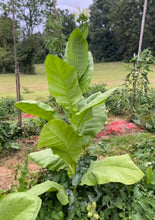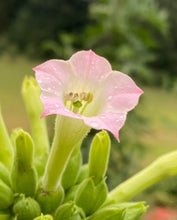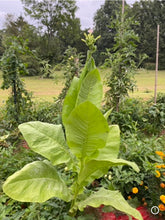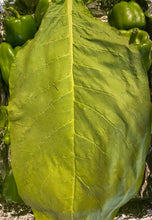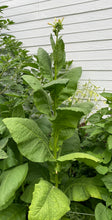Tobacco (Connecticut Broadleaf) seeds
Regular price
$6.50
Sale
Nicotiana Tabacum seeds - 200 minimum seed pack
The most popular and perhaps oldest Americana tobacco cultivar
Connecticut Broadleaf is a tall tobacco plant with an aromatic high grade leaf. Excellent for air drying or flu curing. Considered one of the best varieties of Americana tobacco.
Tobacco farming in the Connecticut River valley has a long history. When the first settlers came to the valley in the 1630s, tobacco was already being grown by the native population. The town of Windsor is the epicenter of the tobacco industry in Connecticut. The town was founded in 1633 and within seven years it was producing tobacco for personal use and profit. The tobacco being grown was for pipe use, brought up from Virginia since the tobacco variety found in the Connecticut Valley was not as delectable as the Virginian style. It was immediately apparent that the soil from the river, a rich sandy loam, and the hot and short summer of New England yielded an excellent crop each year. Approximately 34,000 acres (140 km2) of land in Connecticut is covered by Windsor Soil, named after the town of Windsor.[1]
Eventually, the popularity of cigars became greater than the pipe. Initially, a tobacco leaf type named Shoestring was grown. This was replaced by broadleaf tobacco, which was the variety that dominated the industry. It was in such high demand that during the Civil War the Connecticut Valley yielded up to ten million pounds per year. The fame of quality Connecticut tobacco was raved about throughout the settled regions of the United States.[2]
By 1700, tobacco was being exported via the Connecticut River to European ports. The use of Connecticut Valley tobacco as a cigar wrapper leaf began in the 1820s. Area farmers grew tobacco for the two outside layers of cigars, the binder and the wrapper. By the 1830s, tobacco farmers were experimenting with different seeds and processing techniques.[3] Knowing that they were not the only players in the cigar wrapper economy, farmers began planting a new tobacco species in 1875, the Havana Seed. This smooth, good-looking leaf yielded a higher percent of quality cigar wrappers.
Just a few decades later, in the late 19th century, a fine grained leaf type imported from Sumatra was adopted for growth in Connecticut.
The demand for high quality cigar wrapper was never ending. This pushed Connecticut growers and scientists to develop a leaf so smooth and golden that it would dominate the market. Farmers and scientists worked together to develop a hybrid to overcome competition from Cuba and Asia. Using over thirty samples from Cuba and Sumatra, Shade Tobacco was born in 1900, and the first shade-leaf tent was put up on River Street in Windsor. The shade tents made of cloth cut sunlight and raised humidity.[4]








